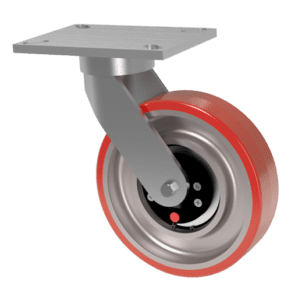

Noise reduction, especially in a busy manufacturing plant, can be serious business. A modest reduction in noise can lead to big benefits in terms of reducing employee downtime, increased productivity, and measurable financial benefits. So, how do you mitigate noise brought on by carts?
First, let’s look at a couple of non-caster-related things you could do to mitigate noise if the noise isn’t at levels above 85 decibels. Any level above that can cause hearing loss, so it requires more of a commitment.
1.) Pad the inside of your cart. Most of the time when there is noise brought on by cart movement, it is exacerbated by the load. Padding the inside of your cart will allow the load to sit on something much softer than the metal/alloy frame that carts are usually made of. Keep in mind that if your load has sharp corners or anything along those lines, the padding will degrade over time.
2.) Leveling areas of the floor that have raises or dips. This may be the most foolproof option, as having a level floor results in the noise coming solely from the wheels turning. This however is not always a realistic option, as most industrial floors are poured with concrete which requires stress joints.
1.) Pneumatic Casters. These types of casters improve working conditions by reducing noise – Pneumatic tires are quiet in use because of their soft rubber tread and shock-absorbing ability.
 2.) Our Patented CasterShox wheel. The wheel allows for variability in the terrain. Essentially, you won’t feel the bumps as much. The wheel has 3/8” of give each way to ensure that all four of the cart’s wheels are on the ground as much as possible! CasterShox is also a critical part of our Drive Systems, allowing the system to stay in contact with the ground as much as possible.
2.) Our Patented CasterShox wheel. The wheel allows for variability in the terrain. Essentially, you won’t feel the bumps as much. The wheel has 3/8” of give each way to ensure that all four of the cart’s wheels are on the ground as much as possible! CasterShox is also a critical part of our Drive Systems, allowing the system to stay in contact with the ground as much as possible.
3.) Spring Loaded Casters. The spring in these types of casters is perfect for sensitive loads. When going over bumps, the spring in the Caster will absorb a lot of the shock caused by the bump. These types of casters are designed to minimize vibrations. And where there are vibrations, there is going to be noise. When using spring-loaded casters, it is important to know your minimum and maximum load. If the load is too light, the spring won’t compress. If the load is too heavy, the spring does something called “bottoming out” where it’s compressed so much it may as well not be spring-loaded at all. Knowing load weight can help determine the proper deflection of the springs for a particular application.
The Occupational Safety and Hazard Administration, or OSHA, sets guidelines for acceptable safety practices in the workplace. Of course, it is possible that noise creates a safety, productivity, or employee satisfaction issue, even if levels are within the recommended OSHA guidelines. Some signs that noise is a problem in your facility include:
As always, consult a rep before making any decision. If you enjoyed this piece of content, make sure you check out our page for more!
Reducing cart noise is not only beneficial for your employees’ well-being but also for the overall efficiency of your industrial operations. Implementing these noise reduction techniques can lead to a quieter and more productive workplace.
Enjoy a quieter and more efficient industrial environment with Caster Concepts’ noise reduction solutions.